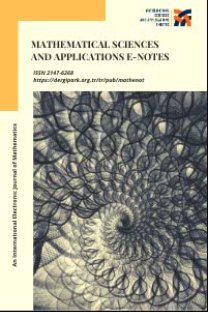Dual-Quasi Elliptic Planar Motion
Dual-quaternions are an elegant and useful mathematical tools for representing rigid-body (screw)
motions in three-dimensional Euclidean space R
3
. The aim of this paper is to consider the algebra of dual
semi-quaternions with their basic properties and generalize the results of the Euclidean-planar motion
given by Blaschke and Grünwald to dual planar motion.
Keywords:
Dual-numbers, Dual Semi-Quaternions Quasi-Elliptic Motion,
___
- [1] WARD, J. P., Quaternions and Cayley Algebrs and Applications, Kluwer Academic Publishers, Dordrecht, 1996.
- [2] Bekar, M. and Yayli, Y., Involutions of Complexified Quaternions and Split Quaternions, Advances in Applied Clifford Algebras (2013), 23, 283–299.
- [3] Bekar, M. and Yayli, Y., Dual-quaternion Involutions and Anti-Involutions, Advances in Applied Clifford Algebras (2013), 23, 577–592.
- [4] Ell, T. A. and Sangwine, S. J., Quaternion Involutions and Anti-involutions, Computers and Mathematics with Applications (2007), 53, 137–143.
- [5] Blaschke, W., Euclidian kinematics and non-Euclidian geometry I, II, Zeitschrift für Mathematik und Physik (1911), 60, 61–92.
- [6] Pottman, H., and Wallner, J., Computational Line Geometry, Springer-Verlag, Heidelberg, 2001.
- [7] Blaschke, W., Differential Geometrie and Geometrischke Grundlagen ven Einsteins Relativitasttheorie, Dover, New York, 1945.
- [8] Fischer, I. S., Dual-Number Methods in Kinematics, Statics and Dynamics. Boca Raton London New York Washington D.C.: CRC Press, 1999.
- [9] Hacisalihoglu, H.H., Hareket Geometrisi ve Kuaterniyonlar Teorisi, Gazi Universitesi Fen-Edb. Fakultesi, 1983.
- [10] Veldkamp, G.R., On the use of dual numbers, vectors and matrices in instantaneous spatial kinematics, Mech. Mach. Theory (1976), 11(2), 141–156.
- ISSN: 2147-6268
- Yayın Aralığı: 4
- Başlangıç: 2013
- Yayıncı: -
